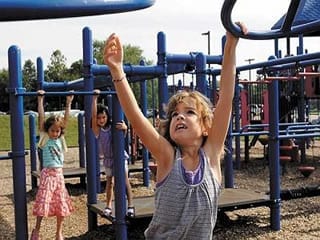October 2010

Pioneer Press – Elmhurst, IL
Computers and the Internet are changing the way many children learn, but one part of the school day that has remained fairly consistent is recess.
“We all need fresh air and exercise to rejuvenate us,” said Melinda McMahon, principal of Madison School in Hinsdale.
Call them “brain breaks” in the classroom, said Jane Bailey, principal of Fischer School in Elmhurst. “Without a doubt, we all need breaks in our day. Adults go get a cup of coffee. Children don’t do that.”
Instead, they have recess, which researchers say not only re-energizes their brains, but provides a much-appreciated opportunity to burn off extra energy. Elementary school students in Elmhurst Unit District 205 split their hour lunch break with 30 minutes for eating and 30 minutes for recess.
Recess also serves as an outdoor classroom.
“Socialization is supposed to be part of school,” Bailey said. “That’s recess.”
Although children are supervised during recess, they make the decisions about what they want to do during recess.
“It allows children the opportunity to lead, to lead the games,” McMahon said. “It’s a good time to practice their social skills and conflict resolution.”
The upper grades in Madison elementary school get a 25-minute recess attached to their lunch. The younger students get that, plus another 15-minute recess in the morning or the afternoon.
Madison and other Hinsdale-Clarendon Hills Elementary District 181 schools are engaged in an initiative called “Social, Emotional Learning for Academic Success.”
It’s part of educating the whole child, McMahon said.
Peaceful Playgrounds at Elm School
Recess provides children the opportunity to handle conflicts.
 Elm School in Burr Ridge is using the Peaceful Playground program, purchased with the help of a grant from the District 181 Foundation.
Elm School in Burr Ridge is using the Peaceful Playground program, purchased with the help of a grant from the District 181 Foundation.
Peaceful Playgrounds complements the work the staff already had been doing on helping children solve conflicts, specifically during recess.
The program kit includes directions and stencils to draw the markings for a wide variety of games, such as hopscotch, ball hopscotch, foursquare and an alphabet grid.
The greater their choices, the more likely children will be able to find a game or activity they will enjoy, Elm principal Jeana Considine said.
“It’s more about the safety aspect of it, to prevent bullying and give children equal access to any game they’re playing,” Considine said. “Sometimes it’s about picking teams that are fair.”
She and her staff try to balance the freedom of unstructured play with the importance of fun and fair play.
“When I was growing up, we played ‘kick the can’ until the streetlights came on and we went home,” Considine said. Now, children’s days are so structured, she did not want to add structure to their recess. “We don’t want to say, ‘You have to play this.'”
“But kids were making up their own rules, and they were not necessarily fair rules,” Considine said.
During one teacher Institute Day, a retired physical education teacher taught the faculty and playground supervisors the standard rules for games students typically play during recess, including kickball and soccer.
Considine had heard from students that “calls” during games were a frequent source of arguments.
“He said he was safe, he said it was on the line …,” Considine recalls the students saying.
They hope having consistent, agreed-upon game rules will eliminate some arguments; the others can be settled by one of three ways.
“You can talk out the conflict, you can just walk away, or you can use rock, paper, scissors,” Considine said.
Arguing over whether a ball was on the line or out in a game of foursquare may be the perfect time for rock, paper, scissors, Considine said. “And it’s one time, not three out of five, we tell them.”
Other disagreements may not be solved so simply.
“We developed lessons to teach children the strategy to talk out conflicts. The social worker and I visited all the classrooms and presented lessons to everyone,” Considine said.
“Supervisors cannot see everything that is going on. We want to empower kids to solve their own problems, by giving them the tools and the words they need to solve these conflicts.
“It’s not perfect. We’re still working on the conflict part of it.” But recess provides children “the opportunity to handle conflicts, so they are ready to handle conflicts as adults,” Considine said.
At the same time, “It’s about having a good time together and making sure recess is a fun time for everybody.”


